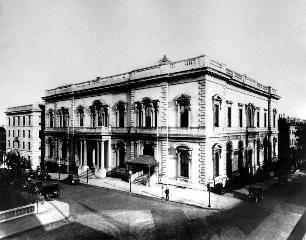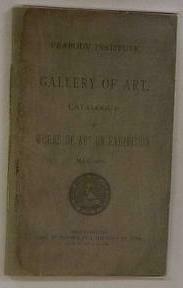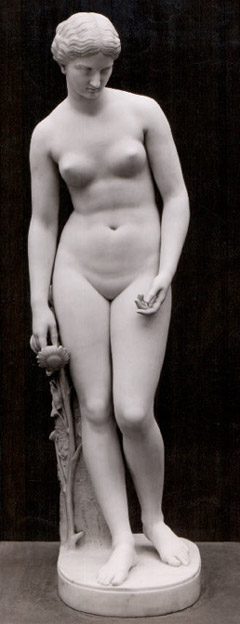A Taste for the Fine Arts - George Peabody's Gift to Maryland
- A Message from Edward Papenfuse and Matthew Lalumia
- An Introduction from the Curators
- George Peabody
- The Peabody Gallery of Art
- A Tour of the Exhibition in Government House
- Works from the Peabody Collection on exhibit in Government House

The Peabody Institute, View from Mt. Vernon Place, Baltimore, Maryland c.1866. Courtesy, The Peabody Institute Archives
The Peabody Gallery of Art - a History
" I have determined, without further delay, to establish and endow an Institute in this City, which, I hope, may become useful towards the improvement of the moral and intellectual culture of the inhabitants of Baltimore, and collaterally to those of the State; and, also, towards the enlargement and diffusion of a taste for the Fine Arts...I contemplate with great satisfaction, as an auxiliary to the improvement of the taste, and, through it, the moral elevation of the character of the society of Baltimore, the establishment of a Gallery of Art in the department of Painting and Statuary...it should be supplied to such an extent as may be practicable, with the works of the best masters, and be placed under such regulations as shall secure free access to it, during stated periods of every year, by all orderly and respectable persons who may take an interest in the works of this kind..."
--George Peabody, February 12, 1857
For George Peabody, founder and benefactor of the Peabody Institute, the cultivation of a taste for the fine arts was particularly important. Founded in 1857, Baltimore's Peabody Institute was the first major cultural center in an American city. It provided Baltimore with a research library, scholarly lectures in the humanities and sciences, an academy of music, and a gallery of art. The encouragement of public appreciation of the meaning and purpose of fine arts was central to the mission of Peabody's Institute in Baltimore and for many of the museums established in the years that followed, including the Corcoran Gallery of Art and the Peabody Institute's Rineheart School of Sculpture (now a part of the Maryland Institute College of Art).

View of the Peabody Art Gallery, c.1881. Courtesy, The Peabody Institute Archives
The Gallery of Art was of special concern to George Peabody. It was the only segment of the Institute to be mentioned specifically in his final 'Letter of Gift.' Following George Peabody's death in 1869, his dream to improve the culture of Baltimore gained strength. Long before the establishment of the Walters Art Gallery and the Baltimore Museum of Art, the Peabody Gallery afforded Marylanders the opportunity to view important works of art. The entire second floor of the Institute's building overlooking Mount Vernon Place was originally devoted to the Gallery of Art. The Peabody Collection was first exhibited to the public in May of 1881--open to all over age six with free admission. On display were sculptures cast from objects of antiquity, Renaissance pieces, and largely American works: paintings, drawings, watercolors, sculptures and decorative arts, including art rendered by Marylanders working at home and abroad. Art students were encouraged to draw the 'ancient casts,' and all were encouraged to use the exhibition catalogue as a means for understanding the history of the objects, their creation, and artistic expression.

Peabody Art Gallery Exhibition Catalogue, 1881. Courtesy, The Peabody Institute Archives
The exhibition catalogue of 1881 became widely circulated, and was used in Baltimore City schools as a textbook and introduction to the arts. It fact, it achieved such popularity that the first edition of 2,000 copies sold out almost immediately. The catalogue, which went into three editions, sold for ten cents.
Although a well-known gallery of art, the Peabody Institute did not begin to collect art until 1873, when John W. McCoy, a Peabody trustee, presented a sculpture by Maryland sculptor William Henry Rinehart-- Clytie. [MSA SC 4680-20-0160].

Clytie (sculpture). [MSA SC 4680-20-0160]
Over the years the Peabody Gallery became the recipient of a number of outstanding collections belonging to prominent Marylanders, including Charles James Madison Eaton, John W. McCoy and George Carter Irwin.
By the mid 1930s the growth of the Peabody Conservatory of Music and its urgent need for space occupied by the art gallery prompted the decision to close the gallery. The Walters Art Gallery and the Baltimore Museum of Art had by this time become premier repositories in Maryland, with the Peabody holding a lesser place. Much of the collection was placed on loan to the Baltimore Museum of Art, the Maryland Historical Society, and the Walters Art Gallery.
Despite the closure of the Peabody Gallery, George Peabody's vision of culture, taste, and fine arts, had far reaching effects. In addition to the realization of the Peabody Gallery in Baltimore, the decade following George Peabody's death saw the founding of some of America's leading cultural institutions: the Metropolitan Museum of Art, Boston Museum of Fine Arts, The Art Institute of Chicago, and the Cincinnati Museum of Art.
Works of art from the Peabody Collection are widely exhibited today, especially works by American Impressionists Mary Cassatt, Thomas Wilmer Dewing, and Childe Hassam. Dewing's Lady with a Fan , now on view in Government House, has been enjoyed by art patrons in exhibitions in Paris, Eastern Europe, as well as in the Smithsonian Institute's exhibition, American Impressionism and a recent Dewing retrospective at the National Gallery of Art in Washington D.C.
The Peabody Collection was acquired by the State of Maryland in 1996 to ensure that this remarkable collection, so rich in portraits of prominent Marylanders, regional scenes and works by Maryland artists would be preserved in perpetuity for the citizens of the State. A Taste for the Fine Arts is the first exhibition of works as a collection since they were on exhibit in the Peabody Gallery.
|
This web site is presented for reference purposes under the doctrine of fair use. When this material is used, in whole or in part, proper citation and credit must be attributed to the Maryland State Archives. PLEASE NOTE: The site may contain material from other sources which may be under copyright. Rights assessment, and full originating source citation, is the responsibility of the user. |
© Copyright December 15, 2023 Maryland State Archives
